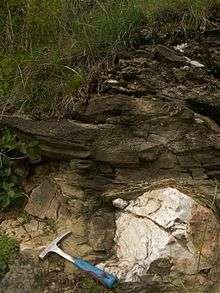Wetterstein limestone
| Wetterstein limestone Stratigraphic range: Middle—Late Triassic Ladinian–Carnian | |
|---|---|
| Type | Geological formation |
| Thickness | 600 m |
| Lithology | |
| Primary | Limestone |
| Location | |
| Region | Alps, Central Europe |
| Country | Austria, Germany, Switzerland |
Wetterstein limestone (German: Wettersteinkalk) and Wetterstein dolomite (Wettersteindolomit) are the most common names for a carbonate rock from the Middle Triassic epoch of the Ladinian stage, comparable to the German stage in which Muschelkalk rock strata were formed.
The rock gets its name from the Wetterstein Mountains, because the Wetterstein limestone is the bedrock of large mountains here. The center of its distribution, however, is in the Karwendel Mountains. It occurs in the Northern and Southern Limestone Alps and in the Western Carpathians.
Geology

The rock is found in the whole of the Alps, in many places as limestone (calcium carbonate), in many others as dolomite. In many areas there is a frequent alternation of limestone and dolomite facies.
Subunits
Its subunits include:
- Messerstich Limestone
- Schlern Dolomite
- Marmolata Limestone
- Steinalm Formation
- Ramsau Dolomite Formation
Fossils
Because, during dolomitisation, traces of fossils are largely lost as a result of recrystallisation, fossils in the Wetterstein dolomite are harder to distinguish, and even in thin sections may be barely recognizable. Wetterstein dolomite is rarely as bituminous as typical Main Dolomite and therefore tends to be much more pure and brighter-coloured. Otherwise, there are no fundamental differences with the Wetterstein limestone.
See also
- List of types of limestone
- Triassic Europe
References
- McCann, Tom (2008). The Geology of Central Europe: Mesozoic and Cenozoic, Vol. 2, Geological Society; Pap/Cdr edition (Sep 2008), ISBN 978-1-86239-265-6
External links
- World map at the time of the Early/Lower Triassic
- Cephalopod coquina beds in the Wetterstein Limestone
| Triassic Period | ||
|---|---|---|
| Lower/Early Triassic | Middle Triassic | Upper/Late Triassic |
| Induan |Olenekian | Anisian | Ladinian | Carnian | Norian Rhaetian |